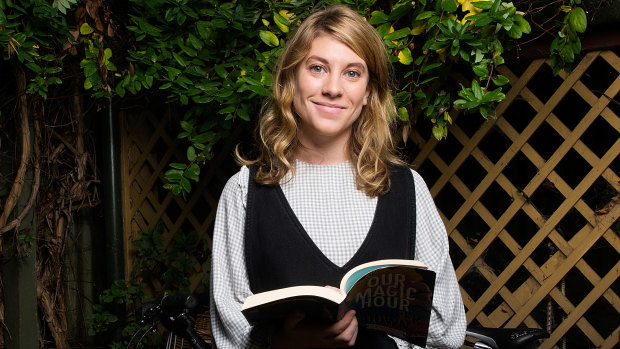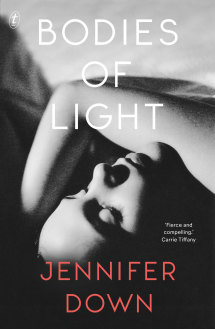This was published 3 years ago
Staggering in its scope, new book is a balancing act of light, dark and brilliance
FICTION: Bodies of Light, Jennifer Down, Text, $32.99
Bodies of Light is many things at once: a crime novel, a mystery novel, an epic, a testimony. The third book from Jennifer Down is staggering in its scope, encompassing half a century of life lived by its magnetic and mystifying central character, Maggie Sullivan – or Josephine, or Holly, depending on who you’re asking.
The year is 2018 when the Facebook message arrives: “Wondering if you are any relation of Maggie Sullivan (Aussie), she went missing a long time ago.” The sender has seen a viral image, and is struck by how much the woman known as Holly – at this stage living a simple life in the US – looks like someone he lived in foster care with as a child. Panicked, Maggie deletes the message and blocks the sender – and begins, privately, to excavate the life she has deliberately buried.
From the Victorian suburbs and shorelines to Sydney, to New Zealand to the US, the story that follows is a sweeping, breathless saga that charts a life that could be two, or three, or more. Maggie’s life is undoubtedly tragic, beginning with her removal from her family at the age of five and years moving from home to home, frequently enduring horrific abuse at the hands of her guardians.
Down drew inspiration from first-person accounts by residential and out-of-home care leavers to bring this part of the story to life in a realistic way. She does not shy away from the grim realities and failings of the system, or the ways in which girls and women are routinely used and discarded by society, shown through Maggie’s transient, often transactional relationships.

At the heart of Jennifer Down’s novel, Bodies of Light, is the idea of reinvention.Credit: Jennifer Soo
Maggie is a perplexing character, equal parts lucid and foggy. The book shines in the middle section, in which a police investigation takes place regarding a crime that she may or may not have committed. Here, Maggie’s occasional role as an unreliable narrator emerges. Down expertly plays intimate scenes depicting the character’s actions and thoughts against police interview transcripts, and the reader is left with little clarity as to what actually happened.
There are also moments when Maggie herself is unsure whether she has blacked out and forgotten something; after this, the character’s first vanishing act occurs. It’s incredibly clever writing that fortifies Down’s point about the fallibility of trauma-impacted memory – the novel is Maggie’s testament to herself, her mind the only proof she has of her existence at all, yet there are still gaps that cannot be filled, even by herself.
What’s remarkable about the novel is the way in which Down balances this darkness with small moments of beauty, rendering Maggie’s complex, harrowing life with grace, humanity and hope. One particularly memorable scene sees Maggie and her first husband observing the brilliance of bioluminescence at Phillip Island in the dead of night, lending a brief moment of awe and magic to their relationship, dying under the weight of grief.

Credit:
Bodies of Light is a natural progression in Down’s writing, building on the best aspects of her previous works. She has always excelled at sketching portraits of people in their most difficult moments. Her 2016 first novel, Our Magic Hour, followed a tightknit group of twentysomethings grappling with a close friend’s suicide in Melbourne.
The following year, the author inhabited disparate lives in the short-story collection Pulse Points: a custody battle, a couple grappling with the grief of miscarriage, a sister going on a pilgrimage following her brother’s suicide to look for answers. These stories took the reader all around the world, from small-town Australia to Japan to the US; Down’s meticulous eye for detail and knowledge of place made each story feel like a vivid world in itself, tied together by her evocative turns of phrase.
Expanding this practice to a novel of this size and scope is a testament to Down’s evolving skill as a storyteller. She inhabits the voice of a man in his sixties writing an email in the late 2010s as convincingly as she does a child in foster care in the 1970s; small pop cultural details (songs, shopping chains, popular authors) are included to cement time.
It’s especially impressive how Down makes locations come alive with exacting details, from street intersections in tiny New Zealand towns to homely local meals in Ann Arbor, Michigan. Reading this book is an immersive experience of travel – a rare pleasure in our current conditions – as well as an intense emotional journey.
At the heart of this sprawling novel is the idea of reinvention – of not being defined by traumatic events but still acknowledging that they have happened, and finding ways to live with, and through, them. Of strength, survival and starting anew. A dignified documentation bearing witness to a life both quiet and immense, Bodies of Light is Down’s strongest work yet.
The Booklist is a weekly newsletter for book lovers from books editor Jason Steger. Get it delivered every Friday.